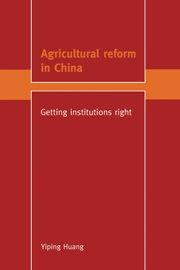Book contents
- Frontmatter
- Contents
- 1 List of figures
- 2 List of tables
- Acknowledgements
- 1 Getting markets to work in the countryside
- 2 Institutional distortions in pre-reform agriculture
- 3 Getting farmers back to work
- 4 Getting prices right
- 5 Adjustments in rural markets bring structural change
- 6 An agricultural economy without freedom to trade
- 7 China's agricultural policy choices
- 8 Chinese farmers can adapt
- 9 Getting reform right in agriculture
- Appendix: The China model
- References
- Index
5 - Adjustments in rural markets bring structural change
Published online by Cambridge University Press: 18 June 2010
- Frontmatter
- Contents
- 1 List of figures
- 2 List of tables
- Acknowledgements
- 1 Getting markets to work in the countryside
- 2 Institutional distortions in pre-reform agriculture
- 3 Getting farmers back to work
- 4 Getting prices right
- 5 Adjustments in rural markets bring structural change
- 6 An agricultural economy without freedom to trade
- 7 China's agricultural policy choices
- 8 Chinese farmers can adapt
- 9 Getting reform right in agriculture
- Appendix: The China model
- References
- Index
Summary
Liberalisation in an imperfect market
Agricultural performance in the wake of reforms from 1979 to 1984 was not all good news. The Chinese economy was still largely closed to international trade in the first half of the 1980s and sectors other than agriculture had not yet been reformed. Agricultural growth was not matched by growth elsewhere in the economy. Between 1982 and 1984, grain output increased by 27 million tonnes per year and cotton by 3.3 million tonnes. In contrast, over the same period, grain demand increased by only 10–12.5 million tonnes a year and annual domestic demand for cotton was roughly 3.5 million tonnes (compared to total output of 6.3 million tonnes in 1984). Temporary agricultural surpluses presented a major policy challenge and caused a number of other economic problems in the early years of agricultural reform. Because the government had traditionally committed itself to buy all grain and cotton output from farmers as long as they wished to sell, large amounts of agricultural output were added to government stocks. In 1983, state grain stocks increased by 37 per cent. And by the end of 1984, total grain stocks had reached a level that was 50 per cent above storage capacity. Huge amounts of grain, roughly 30 million tonnes in 1984, were stored in open areas (Gao and Xiang 1992). Rising stocks of grain and other agricultural products meant heavy burdens on the state budget.
- Type
- Chapter
- Information
- Agricultural Reform in ChinaGetting Institutions Right, pp. 76 - 95Publisher: Cambridge University PressPrint publication year: 1998

